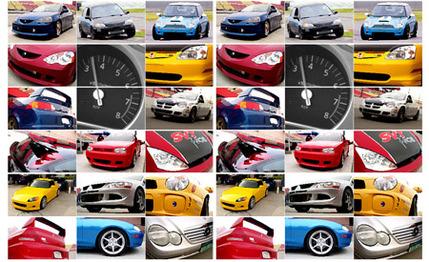
 Comparison Tests
Comparison Tests
Web Exclusives: Get a complete list of pricing and modifications or see the complete run results for each vehicle.
Since 2001, we've hosted an annual two-day competition for modified production cars. The event involved a day of driving on public streets and a day at the track.
Competitors-the tuners who produce these highly modified performance cars-drove their cars (or we did) through a kind of jumbo autocross that included a standing-start quarter-mile run, a road-course section, a blast to 150 mph, and a hard-braking stop from 150 mph-all in one continuous run. The winner was the car that completed the course in the shortest time.
The cars have varied from souped-up Corvettes, Vipers, Mercedes, and Porsches to kit cars such as the Beck Lister and on to exotic production vehicles such as the Mosler MT900. Our supertuner challenge always involved expensive, high-horsepower beasts. Last year's least-expensive entry ("Supercar Challenge," September 2002), as tested, was a Peter Farrell Supercars IS300 Turbo that cost $62,850 and put out 600 horsepower. The priciest one, the Mosler MT900S Photon, was $214,070.
There was one problem, however. The unlimited format-the rules stipulated only that the cars run on pump gas and street tires and could not employ nitrous-oxide injection-meant that a major portion of the tuner market-the modified four-cylinder jobs-had zero chance of competing with the big boys, so they didn't get invitations.
Eliminating coverage of the four-bangers meant we were leaving out a significant segment of the tuner industry. Chris Kersting, president and CEO of the Specialty Equipment Market Association, says, "The sport-compact segment is booming. In 2002, we saw retail sales of $2.3 billion, which is about a 55-percent increase over sales in 2001."
To correct this oversight, we decided to test only four-cylinder tuner cars for 2003. The rules for street tires and pump gas remained in place, and we made three other changes: We lowered the top speed from 150 mph to 130 and split the cars into two classes-front-drivers and rear- or four-wheel-drivers-so there is a winner for each class. We moved the testing venue from Michigan International Speedway to California Speedway in Fontana.
California Speedway is similar to the Michigan track in that it has a 2.0-mile banked oval with an infield road course, but more important, its location in the Los Angeles basin puts it closer to the shops of many of the four-cylinder tuners. Of the 16 cars we tested (10 had front drive, three were rear drive, and three were four-wheel drive), nine came from the L.A. area.
The first day, on public streets, we evaluated the cars for drivability, five stars being best. Then we moved to the racetrack. Each car was permitted five runs of the course, and as usual, the tuners could bring their own drivers or rely on C/D technical editor Larry Webster. If a driver hit a cone or the car was louder than our 103-dBA limit (measured trackside), a five-second penalty was added to the car's overall time.
For recording track times, we once again relied on our GPS-based Racelogic VBOX testing gear. We cannot overstate the value of these devices. They're compact and take just a couple of minutes to move from one car to another. Thanks to the constant software improvements written by VBOX designer Julian Thomas, we were able to quickly sort the data from each run.
Among the numerous performance data you'll see on the following pages, we included our standing-start acceleration time for 0-to-60 mph and quarter-mile speed and elapsed time, which were plucked from the car's quickest overall run. It can seem confusing. In some instances, for example, a car may have recorded a quicker 0-to-60-mph sprint than the one achieved in its fastest overall run.
Keep in mind that the layout of this event prevented us from doing our usual testing procedures. For example, we could not run the cars in two directions to cancel the effect of wind, nor could we adjust the acceleration times to represent how a car would perform under ideal atmospheric conditions. (Cars lose power as ambient air temperature rises and barometric pressure falls.) Judging by the hot, humid weather on test day, it's likely the numbers would have improved a 10th or two, but since these numbers were not corrected, they aren't comparable to figures we regularly publish.
You'll notice how vastly less expensive these cars are than last year's high-powered crowd. The average as-tested price for our four-bangers was about $45,000-18 grand less than last year's cheapest car.
We should also note that some of the companies, such as Vortech Engineering, do not typically build cars; rather, they simply design and manufacture performance parts. When a chance for magazine ink arose, Vortech built a car as a showcase for its equipment. Other outfits, such as Cobb Tuning, do build customer cars. The point is, these exact cars are not available in dealerships, and if you'd like more information, your best bet is to contact the companies.
We expected a few things to happen during this test that did not. We anticipated hearing wildly high horsepower claims, followed soon after by self-destructing engines that had been overtuned and turbocharged to equal those power boasts. But only two of the 16 cars failed to complete all five runs-the same failure rate as for last year's big-engine group. And 450 was the highest claimed horsepower figure.
Although we couldn't say all the cars were perfectly prepared and engineered, many of them were well sorted out. In fact, this group impressed us enough that we ditched our working title for this competition-"Superflea Challenge"-and gave it the more respectable "Superfour Challenge" moniker. Read on to see how this group of "fleas" performed.